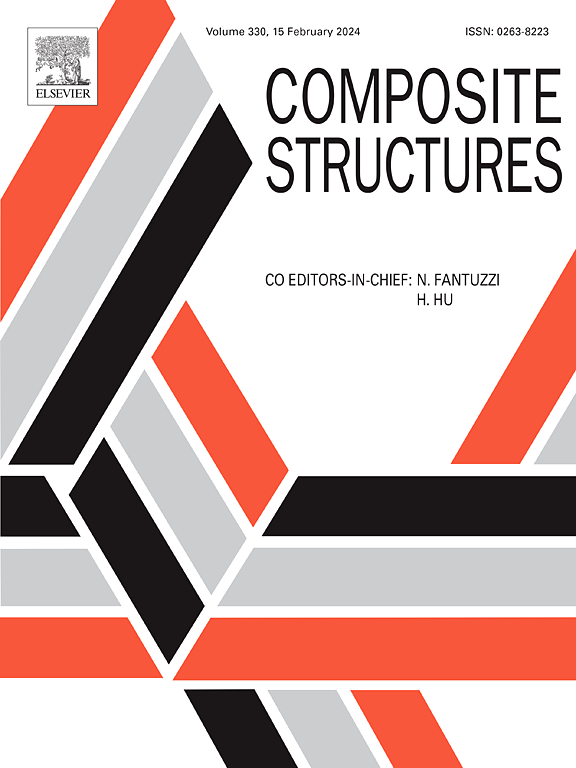用有限元法和平均场均质法研究短切玄武岩纤维增强沥青的弯曲蠕变刚度
IF 6.3
2区 材料科学
Q1 MATERIALS SCIENCE, COMPOSITES
引用次数: 0
摘要
本文采用有限元法和平均场均匀化法研究了短切玄武岩纤维增强沥青(CBFRAs)的弯曲蠕变刚度。首先,利用Matlab人工生成了可靠的玄武岩纤维增强沥青的三维有限元模型。采用钢丝单元和实体单元对纤维进行网格化,对两种有限元模型进行了弯曲数值测试和比较,并与实验结果进行了验证。然后,基于考虑随机纤维取向的Mori-Tanaka方法,建立了两种不同的平均场均匀化分析模型,并将其应用于CBFRAs的弯曲蠕变刚度预测。第三,考虑不同的光纤近似方法进行MFH计算。第四,提出MFH修正系数(MFHAC)方法对MFH预测进行修正,提高对有限元结果的收敛性。最后,将MFH方法与几种传统的微力学模型进行了比较。结果表明,采用线单元和实体单元计算得到的结果存在显著差异,实体有限元模型更加可靠。应特别注意纤维简化数所采用的数值,以便与实验证据正确匹配。所提出的两种MFH分析模型所预测的挠曲蠕变刚度是紧密一致的。在MFH分析中采用的光纤近似方法会影响结果,当实际光纤束表示为基于相同体积-半径准则的椭球包体时,预测更加准确。MFH修正系数法结合MFH提供的结果,可以正确预测cbfra的弯曲蠕变刚度,与标准有限元模拟相比,减少了计算量,提高了计算效率。最后证明了所提出的MFH方法比现有文献中可用的方法更准确。本文章由计算机程序翻译,如有差异,请以英文原文为准。
Study on the flexural creep stiffness of chopped basalt fiber reinforced asphalt using finite elements and mean field homogenization
The aim of the paper is to study the flexural creep stiffness of chopped basalt fiber reinforced asphalts (CBFRAs) using both the finite element (FE) and the mean field homogenization (MFH) method. First, a reliable three-dimensional FE model of a chopped basalt fiber reinforced asphalt is artificially generated with Matlab. Two FE models, in which wire and solid elements are used to mesh fibers, are numerically tested in bending and compared, validating them against experimental results. Then, two different mean field homogenization analytical models based on the Mori-Tanaka approach, which consider the random fiber orientations are developed and applied to predict the flexural creep stiffness of CBFRAs. Third, different fiber approximation methods are considered to carry out MFH computations. Fourthly, the MFH-amending-coefficient (MFHAC) method is proposed to amend MFH predictions, to improve convergence towards FE results. Finally, the MFH methods are compared with several traditional micro-mechanical models available. The results show that there is a significant difference between the results obtained using wire and solid elements, the solid FE model being more reliable. Particular attention should be paid to the values adopted for the fiber simplification number, to match correctly with experimental evidence. The flexural creep stiffness predicted by the two proposed MFH analytical models are closely aligned one each other. The fiber approximation methods adopted during the MFH analysis affect the results, with predictions more accurate when the actual fiber bundle is represented as an ellipsoidal inclusion based on the same-volume-radius criterion. The MFH-amending-coefficient method, combined with the results provided by MFH, can correctly predict the flexural creep stiffness of CBFRAs, allowing a reduction of the computational burden and an increase of computational efficiency when compared with standard FE simulations. It is finally shown how the MFH methods proposed are more accurate than existing methods available in literature.
求助全文
通过发布文献求助,成功后即可免费获取论文全文。
去求助
来源期刊

Composite Structures
工程技术-材料科学:复合
CiteScore
12.00
自引率
12.70%
发文量
1246
审稿时长
78 days
期刊介绍:
The past few decades have seen outstanding advances in the use of composite materials in structural applications. There can be little doubt that, within engineering circles, composites have revolutionised traditional design concepts and made possible an unparalleled range of new and exciting possibilities as viable materials for construction. Composite Structures, an International Journal, disseminates knowledge between users, manufacturers, designers and researchers involved in structures or structural components manufactured using composite materials.
The journal publishes papers which contribute to knowledge in the use of composite materials in engineering structures. Papers deal with design, research and development studies, experimental investigations, theoretical analysis and fabrication techniques relevant to the application of composites in load-bearing components for assemblies, ranging from individual components such as plates and shells to complete composite structures.
 求助内容:
求助内容: 应助结果提醒方式:
应助结果提醒方式:


